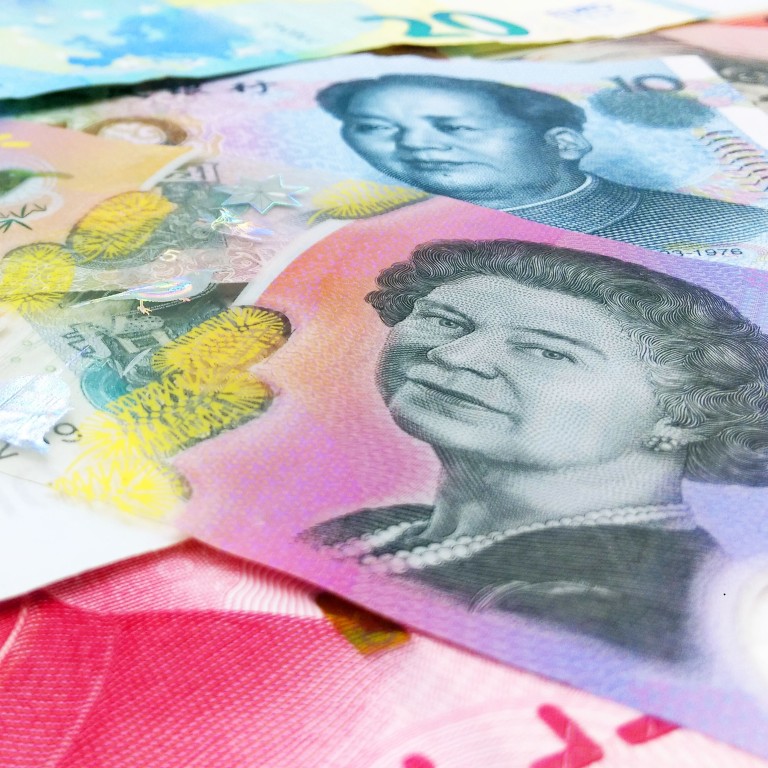
China-Australia relations: how an underperforming Australian dollar could entice new trade partners
- Analysts are looking into whether the Australian dollar has started to weaken recently because of ongoing tensions with China
- When a currency depreciates, that country’s exports generally become more appealing for overseas consumers
With relations between Beijing and Canberra showing little sign of improving, Australia’s dollar has been underperforming in recent weeks, and this could work in the country’s favour when it comes to finding alternative markets that would help reduce reliance on its largest trading partner in the long-term.
After surging by 10 per cent last year as advanced economies recovered and commodity prices surged, the Australian dollar touched a three-year high of 0.7976 to the US dollar in February. But last month it was the worst performer among Group of 10 currencies, according to Bloomberg data.
Generally speaking, a weaker currency stimulates exports by making them cheaper for overseas consumers. The Australian dollar is currently trading at about 0.77 to the US dollar. But if the trade dispute with China worsens, and Chinese consumers buy fewer Australian goods, this could push down the value of Australia’s dollar.
“[It] raises the question on whether Australia can diversify its exports basket in the long run so that it becomes less reliant on shipping its iron ore to China,” said Sean Callow, senior currency strategist at Westpac, referring to the biggest driver of trade between the countries. “We are looking for any indications that the Aussie [dollar] is underperforming due to tensions from China.”
China has since imposed various trade restrictions on a number of Australian exports.
Meanwhile, Asian countries, particularly those that have a significant reliance on China for investment and trade, could find themselves hard-pressed if forced to choose between China and the United States amid the ongoing strategic competition and geopolitical differences between the two biggest economies in the world.
“From a standpoint of sovereignty, both [China and Australia] are unlikely to back down,” said Bernard Aw, Asia-Pacific economist at Coface. “The future development of the China-Australia dispute will be closely monitored by Asian countries for insight into the extent of economic damage potentially suffered, should they become caught in a similar situation.”
Aw said there are also growing concerns that China will harden its stance and start targeting Australia’s tourism and education sectors as economies reopen their borders to international travel.
Where there are no consequences for coercive behaviour, there is little incentive for restraint
The Perth USAsia Centre at The University of Western Australia has estimated that US$28 billion worth of services exports in tourism (US$16.3 billion) and education (US$12.1 billion) – accounting for a combined 6 per cent of total exports – are at risk of further Chinese retaliation.
On Wednesday, Australian Prime Minister Scott Morrison told the Perth USAsia Centre ahead of a meeting of G7 leaders in Britain that the global rules-based order is “under serious strain”.
As Australian exports of goods, mainly commodities, to China account for about 7 per cent of Australia’s gross domestic product, a significant drop in its exports would deal a substantial blow to the economy, they said.
To prepare for this possibility, the Reserve Bank of Australia (RBA) is maintaining a loose monetary policy to keep borrowing costs low and to avoid an unwelcome appreciation of the Australian dollar, which would have an adverse effect on Australian exporters by making their goods less competitive.
According to an RBA study, all other things equal, a 10 per cent depreciation in the Australian dollar’s real exchange rate could increase overall export volumes by about 3 per cent after two years.
Nevertheless, while a cheaper Australian dollar serves to increase the attractiveness of the country’s exports, it is not the sole factor driving export growth, nor will it be the only determining factor in whether Australia can shift its exports from China to other countries.
“Australia also has to build up strong relations with other potential export destinations, as well as to improve the resilience of its export product mix,” Coface’s Aw said. “It needs strong links to foreign markets, physical infrastructure and product quality.”
Additional reporting by AFP

